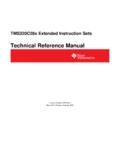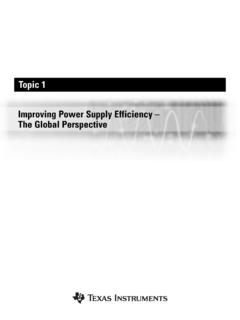Transcription of FLEXMAT GRAVITY ANCHOR- AND MATTRESS SYSTEMS FOR …
1 FLEXMAT GRAVITY ANCHOR- AND MATTRESS SYSTEMS . FOR pipeline stabilization , SCOUR prevention , impact protection AND pipeline SEPARATION (at crossings). CONTENTS. Introduction Research and Development Comparison to in-situ stabilisation SYSTEMS Comparison to weight coat stabilisation FLEXMAT / pipeline stability FLEXMAT /seabed interaction FLEXMAT installation Case histories Design- and Technical Support ATTACHMENTS: (1) Stability analysis printout (specifying required input data). (2) Woodside Statement (3) Testing Statement (AMOG). (4) Design drawing (Woodside TSEP). (5) Tutong drawing (Shell Brunei). (6) Installation frame drawing (Tutong). (7) Design drawing Minerva project(BHP). (8) Pipelay/ FLEXMAT installation (schematic). (9) Veri cation Statement (DnV). (10) Shallow water/breaking wave testing (UWA). (11) FLEXMAT load-out pictures (12) pipeline Flexmats (WMC) and scour control Flexmats (Woodside).
2 (13) FLEXMAT applications in Chervill Field SUMMARY: FLEXMAT GRAVITY anchors and mattresses have been applied for more than twenty years, for pipeline stabilization , scour control around structures, impact protection and as spacers' at pipeline - or cable crossings, in Australian waters (*) as well as overseas. (*) mainly on the North West Shelf The system has an excellent, failsafe, track record whilst permitting some lateral pipeline displacement during extreme sea states. (in accordance with DnV. Guidelines). The use of GRAVITY anchors instead of weight coating (or to minimize its thickness) renders a signi cant reduction in required supplementary weight per linear metre and in overall cost. As a consequence of its reduced weight, the allowable free span of the pipeline increases substantially. (before overstressing would occur).
3 By comparison, alternative methods of stabilisation such as trenching, mechanical anchoring and rock dumping are far more costly and relatively unreliable. (as evidenced by the substantial failure record of these SYSTEMS , especially during extreme sea states). FLEXMAT GRAVITY anchors and scour prevention mattresses can be installed at a fast rate without requiring sophisticated installation equipment. A simple spreader beam frame would normally suf ce. Extensive testing has shown that it would be possible to install the anchors during the pipelay process. This would avoid the cost of a separate installation spread (as required for post' installation of the anchors). INTRODUCTION: The rst pipeline Flexmats were manufactured in 1984 for free span control at various locations along Woodside's Rankin trunk line.
4 This was followed by large FLEXMAT supplies in 1986, 1987 and 1995 for scour prevention near structures and pipelines in the Rankin, Goodwin and Wanaea Developments. From 1987, FLEXMAT Anchors were used to stabilise more than twenty offshore and coastal pipelines and pipeline bundles, mainly on the North West Shelf, in waters subject to extreme -cyclone generated- sea states. Most of these lines are still in operation without any loss of stability and at negligible maintenance cost. RESEARCH AND DEVELOPMENT: In 1990, the system was thoroughly reviewed by Wholohan Grill and Associates. In accordance with their recommendations the sound analytical- foundation of the FLEXMAT system was underpinned by an extensive R & D program which included: Extensive ume testing at the University of Western Australia for realistic current- and wave scenario's.
5 Manufacturing trials on high-density concrete versions;. veri cation of stability analysis software by DnV;. feedback from installation Contractors and the operators of ( FLEXMAT stabilized) pipelines;. The outcome if this program, in conjunction with successful project applications, con rmed that FLEXMAT GRAVITY anchors are capable of providing reliable, long-term, stability to pipelines, pipeline bundles and piggy-back' pipe/umbilical assemblies, even during extreme sea states and at all water depths.(up to the shoreline). Subsequent large-scale testing, including offshore eld trials, conducted by Australian Marine & Offshore Group in regard to Woodside's TSEP (42 ) trunkline con rmed that even for an untrenched pipeline of such large diameter the FLEXMAT system could be successfully applied, requiring anchors with a weight of approx.
6 30 T. (re. AMOG's conclusions in attachment 3). The same testing program also con rmed that the anchors will not dislodge from the pipeline during extreme sea states and that, in erodable bed material, the anchors subside at the same rate as the pipeline , preventing the anchor's bridles from becoming slack. As the exposure height of the pipeline /anchors assembly (relative to the surrounding seabed) decreases, the destabilizing (hydrodynamic) force decreases accordingly. This renders an increase in the factor of safety. COMPARISON TO IN-SITU STABILISATION SYSTEMS : These traditional SYSTEMS , which include trenching, mechanical anchoring and rock dumping, are far more costly than GRAVITY stabilization SYSTEMS and have a relatively poor performance record, especially in waters subject to extreme -cyclone generated- sea states.
7 It explains the numerous cases of total or partial failure of such SYSTEMS , either during the installation stage or later on. (most common problems: inadequate trenching depth and/or snail's progress of trencher; deterioration and/or subsequent failure of mechanical anchors, degrading and/or subsidence of rock berms over time). Also, and most importantly: once failed, these SYSTEMS can not recover. A typical example was the chain' failure of rock bolts on the Varanus pipeline (on the North West Shelf). over many kilometres, necessitating very costly remedial work over many months. COMPARISON TO WEIGHT-COAT STABILISATION: Application of GRAVITY anchors reduces required weight coating thickness and eliminates the need for weight coating altogether in cases where the (steel) pipe has suf cient negative buoyancy and is not at risk of impact damage caused by ship's anchors or trawl boards.
8 The reduction or elimination of weight coating reduces the pipeline 's external diameter and, as a consequence, the peak hydrodynamic forces on the pipeline . This means that, for a certain required factor of safety, required pipeline weight (and the weight and/or number of GRAVITY anchors) decreases. (approx. in linear proportion to the reduction in pipe OD). This is especially important in shallow water where, due to a large -wave induced- acceleration force, required weight coat thickness would, otherwise, become excessive. (due to the fact that maximum weight coat density is technically limited to roughly T/m3). By contrast, FLEXMAT anchors and mattresses for shallow water application can be supplied with a concrete density up to roughly T/m3 at only a slight increase in cost per Tonne of submerged weight.
9 Also: by minimizing weight coat thickness (if any), the weight of the pipe joints reduces substantially. This facilitates storage and handling and reduces haulage costs substantially. Also and most importantly: the reduction of the pipe-line's OD and weight makes it possible to engage a smaller pipelay barge at exponentially reduced day rate. Also, the weight coating process requires sophisticated rotary machinery. By contrast, the FLEXMAT 's fabrication technology is simple. (only requiring tack-welded steel moulds and pencil vibrators). Consequently, FLEXMAT anchors or mattresses can be supplied at short notice. Haulage cost are minimized if the production facility can be located close to the load-out point. Examples of projects where weight coat thickness was kept to a minimum (with the required supplementary weight provided by FLEXMAT anchors) are the tanker loading lines operated by WAPET and Chevron in the Saladin- and South Pepper Fields (both with an OD of 550 mm) and Shell Brunei's Tutong pipeline .
10 (OD 600 mm). FLEXMAT / pipeline STABILITY: FLEXMAT GRAVITY anchors differ fundamentally from other types of GRAVITY anchors or mattresses in that: the concrete blocks t tightly around the pipeline , eliminating the risk of dislodging and the anchor pro le is streamlined, increasing overall weight ef ciency due to a proportionate reduction in hydrodynamic drag- and lift forces. Stability computations of the FLEXMAT / pipeline system are based on conventional 2-D analysis for the signi cant wave condition using Morison's well proven hydrodynamic force equations with conservative values for the drag- lift- and inertia coef cients.(based on experimental work performed by Jacobson and Lambrakos et al) including the incremental effect of wake ow reversal. (in accord. with DnV's Rules and Recommended Practice E305). Hydrodynamic coef cient values for the FLEXMAT anchor pro le were calculated mathematically and con rmed experimentally.






